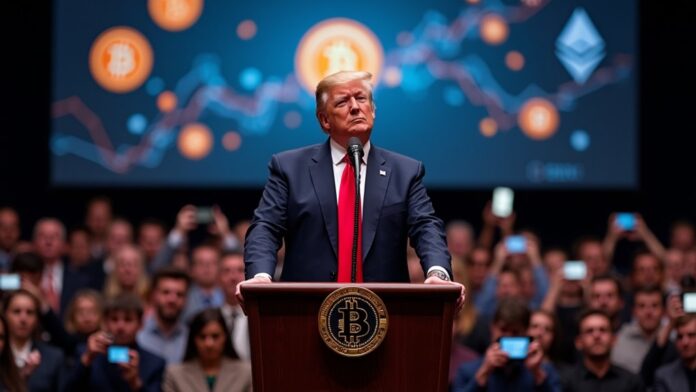The Trump administration’s initiative to overhaul the U.S. cryptocurrencyA digital or virtual currency that uses cryptography for sec market introduces an extensive regulatory framework aimed at providing clarity and stability. This shift to a transparent regulatory approach enhances market potential and investor trust, with a strategic focus on blockchainA decentralized ledger that records transactions across a ne technology and a U.S. Bitcoin reserve. Moreover, the administration halts CBDC advancements to preserve dollar stability, setting the stage for significant developments in the crypto sector. Learn how these steps may reshape the digital asset landscape.
As the Trump administration forges a new path in the digital asset landscape, it establishes a detailed regulatory framework to bring clarity and confidence to the U.S. cryptocurrency market. This strategic initiative is underscored by the formation of a dedicated working group mandated to propose an extensive federal regulatory framework for digital assets within 180 days. The goal is to provide regulatory certainty, a key element of Trump policies, which can meaningfully impact market growth by reducing ambiguity that has historically deterred potential investors. The Working Group on Digital Asset Markets, chaired by David Sacks, will review existing regulations and provide recommendations within 60 days.
A notable shift in the regulatory landscape includes the repeal of Executive Order 14067, a holdover from the previous administration, marking a decisive move away from prior crypto regulations. This change reflects a commitment to reevaluating existing policies, with the working group reviewing regulations and recommending which to rescind, modify, or retain within 60 days. Such actions underscore the administration’s focus on structured regulatory approaches, moving from the SEC’s previous approach of “regulation by enforcement” to a more predictable and transparent framework, fostering an environment ripe for market growth.
Amidst these regulatory advancements, the establishment of a Strategic Bitcoin Reserve positions the U.S. as a formidable player in the global digital asset arena. By leveraging existing federal Bitcoin holdings, the reserve aims to maintain Bitcoin as a store of value without plans for sale, thereby strengthening the U.S.’s strategic financial posture. The Reserve will treat bitcoin as a reserve asset, enhancing its strategic importance and aligning with global financial practices. This move could influence global perceptions of Bitcoin and reinforce its legitimacy as a reserve asset, aligning with the administration’s broader support for blockchain technology.
The administration’s policy objectives extend to fostering a supportive environment for blockchain support. By championing the responsible growth of blockchain technology, the U.S. aims to secure its position as a leader in digital financial technology innovation. This support isn’t merely rhetorical; it encompasses tangible backing for blockchain development and related applications, which could contribute to meaningful technological advancements and further market growth.
However, the Trump administration remains cautious about the potential implications of Central Bank Digital Currencies (CBDCs). By prohibiting further research into a U.S. CBDC, the administration articulates its CBDC concerns, primarily regarding the impact on the U.S. dollar’s stability and broader monetary policy. This decision suggests a strategic focus on alternative digital financial technologies that don’t threaten the dollar’s preeminence. Agencies are explicitly prohibited from establishing or promoting CBDCs, reflecting a commitment to protect financial system stability and individual privacy.
The administration’s initiatives reflect a nuanced understanding of the crypto landscape, aiming to balance innovation with regulatory oversight. By providing clear guidance and bolstering confidence, these efforts could transform the U.S. into a hub for cryptocurrency innovation, enhancing global competitiveness and attracting meaningful investments.
The focus on structured regulations and strategic asset reserves positions the U.S. favorably amidst growing global interest in digital assets, establishing a blueprint for other nations to follow. In doing so, the Trump administration not only supports the burgeoning crypto sector but also fortifies the nation’s financial future in the digital age.



